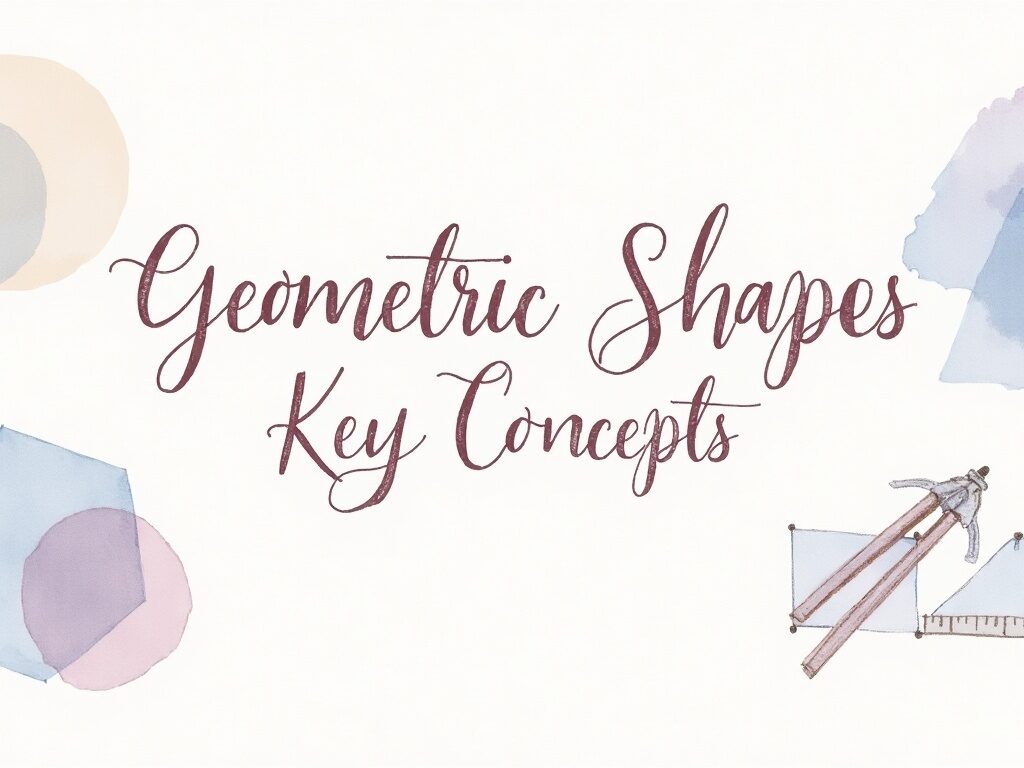Table of Contents
- What Are Geometric Shapes and Their Real-Life Examples
- Common Two-Dimensional (2D) Geometric Shapes and Their Uses
- Exploring Three-Dimensional (3D) Geometric Shapes with Examples
- Key Properties of Popular Geometric Shapes Explained
- Interesting Facts About Lines, Curves, and Shape Boundaries
- Practice Questions to Test Your Understanding of Shapes
- Answers to Common Questions About Geometric Shapes
- Frequently Asked Questions
8.1. What makes a shape geometric, and how is it different from other shapes?
8.2. Can you explain how properties like symmetry and angles help define geometric shapes?
8.3. How do two-dimensional and three-dimensional geometric shapes differ in terms of properties?
8.4. Why are examples like polygons and circles important when learning about geometric shapes?
8.5. How do geometric shapes relate to real-world objects and practical uses?
Geometric shapes are the building blocks of the world we see around us. They are objects made up of lines, curves, angles, and surfaces with clear boundaries that make each shape unique. You can find these shapes everywhere—like a pizza slice shaped as a triangle or a door that’s usually rectangular. Shapes come in two kinds: 2D (flat shapes like circles and squares) and 3D (solid forms like cubes and cones). Each shape has special properties such as edges, vertices, and faces that help us identify them. Understanding these helps improve our spatial skills and makes learning math easier in daily life.
What Are Geometric Shapes and Their Real-Life Examples

A geometric shape is a figure formed by lines, curves, angles, or surfaces that have a clear boundary. These shapes can be either open, meaning they don’t fully enclose an area, or closed, where all the edges connect to form a complete boundary. They come to life by connecting points, lines, and curves in different ways to create unique forms. For example, a slice of pizza looks like a triangle because it has three straight sides meeting at corners. Doors and windows are often shaped like rectangles with four sides and right angles, making them easy to recognize. A wheel is a perfect example of a circle, which has no edges or corners, just a smooth curved boundary. Shapes are everywhere around us, helping us identify objects by their form. Curves and straight lines mix together not only in man-made structures but also in nature, from the roundness of fruits to the outline of leaves. Understanding these shapes allows us to see patterns and connections in the world, making everyday things easier to recognize and describe.
Common Two-Dimensional (2D) Geometric Shapes and Their Uses
Two-dimensional shapes lie flat on a surface and have only length and width, without any height. These shapes are everywhere in our daily lives and serve many practical purposes. Triangles, which have three sides, are often used in traffic signs to grab attention and in building roofs for structural strength. Squares have four equal sides and can be seen in objects like chessboards and floor tiles, providing balance and symmetry. Rectangles, with opposite sides equal, are common in books, doors, and screens, offering a practical shape for many designs. Circles have no edges or corners, making them perfect for wheels, clocks, and plates where smooth rotation or rounded shapes are needed. Ovals look like stretched circles and appear naturally in human eyes and in sports tracks, creating smooth, flowing shapes. Polygons such as pentagons and hexagons, with five and six sides respectively, are found in things like home designs and honeycombs, showing how nature and architecture use these efficient shapes. Understanding these flat shapes helps in drawing, measuring, and building, as they can be combined in countless ways to create patterns, artwork, and functional designs. Whether in art, design, or everyday objects, 2D shapes form a basic but powerful foundation in how we organize and understand space around us.
For instance, jewelry design often embraces geometric shapes such as circles, ovals, and polygons to craft visually striking rings, pendants, and earrings. The timeless round solitaire showcases how shape influences both aesthetic appeal and symbolic meaning. In more expressive pieces like those found in a thoughtfully curated ruby rings collection, designers use bold geometric arrangements to highlight the gemstone’s rich red hue and emotional significance. These artistic choices reveal how geometry plays a powerful role in both the structure and storytelling of fine jewelry.
Exploring Three-Dimensional (3D) Geometric Shapes with Examples

Three-dimensional (3D) geometric shapes are objects that have length, width, and height, which means they occupy space and have volume. Unlike flat 2D shapes, 3D shapes take up real space and can be touched or held. For example, a cube has six equal square faces, much like a dice or a box. Its equal edges and faces make it easy to recognize. A cuboid also has six faces, but they are rectangles instead of squares, similar to the shape of a book or a brick. Spheres are perfectly round shapes, like basketballs or oranges, with no edges or corners. Cylinders have two circular flat ends connected by a curved surface, much like a soda can or a pipe. Cones have a circular base that narrows smoothly to a single point or apex, similar to an ice-cream cone or a party hat. Hemispheres are exactly half of a sphere, resembling objects like bowls or igloos. In real life, 3D shapes can be solid, like a wooden cube, or hollow, like a metal can. Understanding these shapes helps us grasp the structure and form of everyday objects, making it easier to visualize and work with them in both practical and creative ways.
Key Properties of Popular Geometric Shapes Explained

When exploring geometric shapes, understanding their key properties helps you visualize and classify them easily. Edges are the straight lines where two faces or sides meet, while vertices are the points or corners where edges come together. Faces refer to the flat surfaces found on 3D shapes.
For 2D shapes, take the square as an example. It has 4 edges and 4 vertices, with all sides equal in length and each angle exactly 90 degrees. Rectangles share the same number of edges and vertices but differ because only opposite sides are equal, though their angles are still 90 degrees. Triangles have 3 edges and 3 vertices, and an interesting property is that the sum of their interior angles always adds up to 180 degrees. Circles are unique among 2D shapes because they have a continuous curved edge with no vertices or corners.
Moving to 3D shapes, cubes are quite fascinating. They have 12 edges, 8 vertices, and 6 square faces, all equal in size, making them very symmetrical. Cylinders have 2 edges, which are the circular rims at the top and bottom, but they don’t have any vertices since the sides curve smoothly. Cones stand out with just 1 edge—the circular base—and 1 vertex, the apex or pointed tip.
These properties are more than just numbers; they define how these shapes behave and interact with space. For instance, knowing that a cube has 12 edges and 8 vertices helps in visualizing its 3D structure, while the lack of vertices in a cylinder reminds us it has smooth, curved surfaces. Real-life objects like dice (cubes), cans (cylinders), and ice cream cones (cones) showcase these properties clearly, making geometry practical and easy to grasp.
| Shape | Type | Edges | Vertices | Faces | Notes |
|---|---|---|---|---|---|
| Square | 2D | 4 | 4 | — | All sides equal; all angles 90° |
| Rectangle | 2D | 4 | 4 | — | Opposite sides equal; all angles 90° |
| Triangle | 2D | 3 | 3 | — | Sum of interior angles = 180° |
| Circle | 2D | Curved | 0 | — | No edges or vertices |
| Cube | 3D | 12 | 8 | 6 square faces | All edges equal |
| Cylinder | 3D | 2 | 0 | 3 (2 circular bases + curved surface) | No vertices |
| Cone | 3D | 1 | 1 | 2 (1 circular base + 1 curved surface) | Apex point |
Interesting Facts About Lines, Curves, and Shape Boundaries

Lines, whether straight or curved, are the basic building blocks of all shapes. They come together to form boundaries that define the shape’s space. Closed shapes like squares and circles have lines or curves that connect at every end, forming a complete boundary. On the other hand, open shapes such as line segments or open curves do not connect at all ends, so they don’t fully enclose an area. Curves give certain shapes a smooth, flowing look; for example, circles have continuous curved boundaries with no corners or straight edges. Triangles are the simplest closed shapes made entirely of straight lines meeting at vertices, which are the points where the lines join. Polygons, like pentagons or hexagons, have many sides and corners, and they can be regular, where all sides and angles are equal, or irregular, where they vary. When lines and curves combine, they create more complex shapes that we often see in nature and art, such as leaves, waves, or intricate designs. The boundaries of shapes are not just visual lines; they also represent the exact space the shape occupies, which is important in both art and mathematics for understanding size, area, and structure.
- Lines can be straight or curved and form the building blocks of shapes.
- Closed shapes connect at all ends forming a boundary, like squares and circles.
- Open shapes do not connect all ends, like line segments or open curves.
- Curves in shapes like circles have no corners or straight edges.
- Triangles are made of straight lines meeting at points called vertices.
- Circles have continuous curved boundaries with no edges or corners.
- Some shapes, like polygons, have many sides and corners.
- Shapes can be regular (all sides and angles equal) or irregular.
- Lines and curves combined create complex shapes found in nature and art.
- Shape boundaries define the space a shape occupies visually and mathematically.
Practice Questions to Test Your Understanding of Shapes
Ready to check how well you know your shapes? Try answering these questions to see what you’ve learned. What 2D shape has no straight edges? That’s right, a circle! Now, how many edges does a cube have? If you said 12, you nailed it. Think about 3D shapes: which one has a circular base and comes to a sharp point? It’s a cone. For 2D shapes with all sides equal and all right angles, the answer is a square. Can you name a shape with six equal square faces? That would be a cube again. What about a 2D shape with three sides? It’s a triangle. Moving back to 3D shapes, which one has two circular bases connected by a curved surface? That’s a cylinder. If you picture half of a ball, you’re imagining a hemisphere. What polygon has exactly five sides? The pentagon is your answer. Finally, what 3D shape is a perfect round figure in all directions? That’s a sphere. These questions not only test your memory but also help you visualize and understand shapes better. Keep practicing, and soon identifying shapes will become second nature!
Answers to Common Questions About Geometric Shapes

What makes a shape 2D or 3D? Two-dimensional shapes only have length and width, so they are flat like a square or circle. Three-dimensional shapes add height or depth, giving them volume, such as cubes or spheres. Is a line a shape? A line alone is one-dimensional, just length, but when lines join together, they form shapes like triangles or rectangles. Are all shapes regular? Not always. Regular shapes have equal sides and angles, like a square or an equilateral triangle, while irregular shapes have sides or angles that differ. Why don’t circles have edges or vertices? Unlike polygons, circles are curved with no straight sides, edges, or corners, so they don’t have vertices. What’s the difference between open and closed shapes? Open shapes don’t completely enclose a space, like a simple curve or an unfinished figure. Closed shapes join end-to-end to create a boundary, such as polygons and circles. Are circles polygons? No, polygons are closed 2D shapes with straight sides, so circles, being curved with no straight edges, are not polygons. How do 3D shapes differ in parts like faces, edges, and vertices? Depending on the shape, 3D objects have flat or curved faces. For example, cubes have flat faces, edges, and vertices, while spheres have one curved surface but no edges or vertices. How are shapes classified? They can be grouped by the number of sides, angles, faces, and symmetry they have. Understanding these properties helps us identify, compare, and describe shapes clearly. Why is knowing shape properties important? It lets us recognize shapes in the world around us, solve problems, and communicate ideas effectively, whether in math, art, or everyday tasks.
Frequently Asked Questions
1. What makes a shape geometric, and how is it different from other shapes?
A geometric shape is defined by specific points, lines, and angles that follow clear rules, like squares or circles. Unlike freeform or irregular shapes, geometric shapes have precise measurements and can be described using math formulas.
2. Can you explain how properties like symmetry and angles help define geometric shapes?
Symmetry means a shape looks the same when flipped or rotated, which is common in many geometric shapes like triangles or hexagons. Angles describe the space between two lines, and knowing the angles in a shape helps identify and classify it, such as right angles in rectangles or equal angles in equilateral triangles.
3. How do two-dimensional and three-dimensional geometric shapes differ in terms of properties?
Two-dimensional shapes have only length and width, like squares or circles, lying flat on a plane. Three-dimensional shapes add depth, so they have length, width, and height, like cubes or spheres, which makes their properties more complex, including volume and surface area.
4. Why are examples like polygons and circles important when learning about geometric shapes?
Polygons and circles represent two broad groups of geometric shapes, each with unique properties. Polygons have straight sides and angles, while circles have a continuous curved edge with no angles. Studying these helps you understand the variety and rules behind different shapes.
5. How do geometric shapes relate to real-world objects and practical uses?
Geometric shapes are all around us in real life, from the triangular supports in bridges to circular wheels. Understanding their properties helps in designing, building, and solving problems because shapes determine strength, balance, and function in many practical applications.
TL;DR Geometric shapes are all around us, from simple 2D figures like triangles and circles to 3D solids like cubes and cones. This blog breaks down their definitions, common examples, and key properties, helping you spot these shapes in everyday life and understand their importance. You’ll also find interesting facts about lines, curves, and shape boundaries, along with practice questions to test your understanding. Whether you’re brushing up on basics or exploring geometry’s role in art and nature, this guide makes the topic easy and engaging.





















